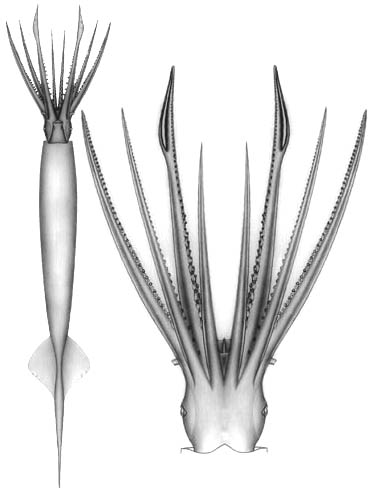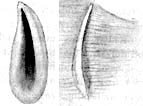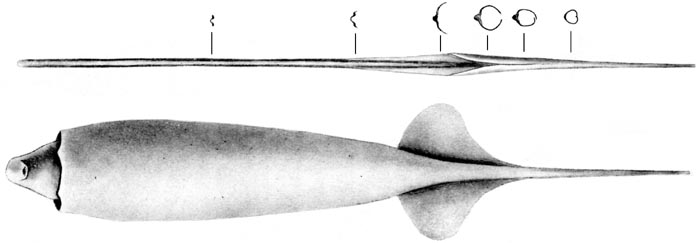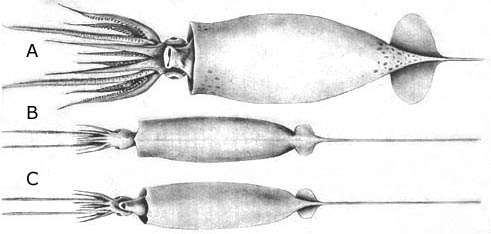Batoteuthidae
Batoteuthis skolops
The Bush-club Squid
Richard E. Young and Clyde F. E. RoperIntroduction
Batoteuthis skolops is found only in Antarctic and subantarctic waters and little is known of its biology. It has a small head, a long tail and a very peculiar tentacle with six series of suckers on the club. It reaches a size of at least 35 cm ML.
Diagnosis
A member of the chiroteuthid families ...
- with each tentacular club bearing suckers in six regular series.
Characteristics
- Arms
- Arms with suckers in two series.
- Arms with suckers in two series.
- Tentacular club
- Club suckers in six series; club about 80% of tentacle length.
- Head
- Beaks: Descriptions can be found here: Lower beak; upper beak.
- Beaks: Descriptions can be found here: Lower beak; upper beak.
- Funnel
- Funnel locking-apparatus is distinctly curved.
- Funnel locking-apparatus is distinctly curved.
- Fins
- Short (about 20% of ML).
- Short (about 20% of ML).
- Gladius and Tail
- Long secondary conus of gladius forms core of long, slender tail; length greatest in paralarvae.
- Photophores
- Large, subadult males with large aboral photophores occupying the tips of arms IV (see title illustration).
- Large, subadult females with small aboral photophores occupying the tips of arms IV.
- Large, subadult males with large aboral photophores occupying the tips of arms IV (see title illustration).
Comments
More details of the description can be found here. The visceral nucleus is located far anteriorly within the mantle cavity.
Nomenclature
The generic name means "thorn-bush" and refers to the bushy tentacular club. The trivial name refers to anything pointed, a reference to the pointed tail.
A list of all nominal genera and species in the Batoteuthidae can be found here. The list includes the current status and type species of all genera, and the current status, type repository and type locality of all species and all pertinent references.
Life History
The smallest known individual is 30 mm ML and the largest, 350 mm ML. Unfortunately, the largest specimen described with intact tentacles is the holotype. A few growth stages have been described. Paralarval and mature individuals are unknown.
Figure. Growth stages of B. skolops. A - Ventral view of subadult (holotype), 51 mm ML, Antarctic waters. B - Dorsal view of of juvenile, 30 mm ML (not including tail), Antarctic waters. Note the long tail and small fins. C - Ventral view of same juvenile . Drawings from Young and Roper, (1968).
Distribution
Type locality: South Pacific Ocean about 1000 km southeast of Wellington, New Zealand in the region of the Antarctic Convergence (49° 57'S; 169° 01'W). This species is found in Antarctic and adjacent waters.
B. scolopes is a pelagic species apparently occupying deep water but no definitive information in available of it's vertical distribution.
References
Nesis, K. N. 1982. Abridged key to the cephalopod mollusks of the world's ocean. 385,ii pp. Light and Food Industry Publishing House, Moscow. (In Russian.). Translated into English by B. S. Levitov, ed. by L. A. Burgess (1987), Cephalopods of the world. T. F. H. Publications, Neptune City, NJ, 351pp.
Young, R. E. and C. F. E. Roper. 1968. The Batoteuthidae, a new family of squid (Cephalopoda; Oegopsida) from Antarctic waters. Antarctic Res. Ser. 2: 185-202.
About This Page

University of Hawaii, Honolulu, HI, USA

Smithsonian Institution, Washington, D. C., USA
Correspondence regarding this page should be directed to Richard E. Young at
Page copyright © 2019 and
 Page: Tree of Life
Batoteuthidae . Batoteuthis skolops . The Bush-club Squid.
Authored by
Richard E. Young and Clyde F. E. Roper.
The TEXT of this page is licensed under the
Creative Commons Attribution-NonCommercial License - Version 3.0. Note that images and other media
featured on this page are each governed by their own license, and they may or may not be available
for reuse. Click on an image or a media link to access the media data window, which provides the
relevant licensing information. For the general terms and conditions of ToL material reuse and
redistribution, please see the Tree of Life Copyright
Policies.
Page: Tree of Life
Batoteuthidae . Batoteuthis skolops . The Bush-club Squid.
Authored by
Richard E. Young and Clyde F. E. Roper.
The TEXT of this page is licensed under the
Creative Commons Attribution-NonCommercial License - Version 3.0. Note that images and other media
featured on this page are each governed by their own license, and they may or may not be available
for reuse. Click on an image or a media link to access the media data window, which provides the
relevant licensing information. For the general terms and conditions of ToL material reuse and
redistribution, please see the Tree of Life Copyright
Policies.
- Content changed 12 August 2009
Citing this page:
Young, Richard E. and Clyde F. E. Roper. 2009. Batoteuthidae . Batoteuthis skolops . The Bush-club Squid. Version 12 August 2009 (under construction). http://tolweb.org/Batoteuthis_skolops/19452/2009.08.12 in The Tree of Life Web Project, http://tolweb.org/













 Go to quick links
Go to quick search
Go to navigation for this section of the ToL site
Go to detailed links for the ToL site
Go to quick links
Go to quick search
Go to navigation for this section of the ToL site
Go to detailed links for the ToL site